Lunar Lander

 The Game: Gene Kranz isn’t around to give you a go/no-go for landing – in Lunar Lander, you’re on your own, trying to use the least fuel to bring your lander down for a soft touchdown on the safest target area available. You can always scrub the landing by pulling the ABORT handle, or you can opt for nerves of steel and try to keep your ship – valued at 100 megabucks, incidentally – in one piece. Failure, as some associated with the moon program have been known to say, is not an option for making that one small step…but if you do litter your landing pod across the lunar landscape so many times that you run out of fuel, you can always try to salvage the space program’s integrity for another quarter. (Atari, 1979)
The Game: Gene Kranz isn’t around to give you a go/no-go for landing – in Lunar Lander, you’re on your own, trying to use the least fuel to bring your lander down for a soft touchdown on the safest target area available. You can always scrub the landing by pulling the ABORT handle, or you can opt for nerves of steel and try to keep your ship – valued at 100 megabucks, incidentally – in one piece. Failure, as some associated with the moon program have been known to say, is not an option for making that one small step…but if you do litter your landing pod across the lunar landscape so many times that you run out of fuel, you can always try to salvage the space program’s integrity for another quarter. (Atari, 1979)
Memories: Atari’s first foray into vector graphics was old news by computer mainframe standards. The basic premise of Lunar Lander had been around as a text-only game, blasting craters into college students’ productivity and computer lab time, for years.
Odyssey2
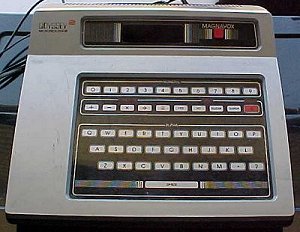 The late 70s and early 80s saw the birth of what is now one of the hottest and most lucrative fields in the electronics industry with the introduction of home video games that weren’t tied down to playing a television equivalent of table tennis.
The late 70s and early 80s saw the birth of what is now one of the hottest and most lucrative fields in the electronics industry with the introduction of home video games that weren’t tied down to playing a television equivalent of table tennis.
The growing home video game craze was far different from its current incarnation, where 16-bit graphics and stereo sound make or break a game. In these days, abstractions were readily accepted so long as the game play itself was suitably enjoyable. Also, the arcade video games hadn’t gotten too terribly advanced or fancy yet; they too still relied on symbols which were, at best, cartoon representations of the player or his computerized opponents. The play, as they say, was the thing. So long as the cake itself tasted good, the icing didn’t need to be too elaborate. It was the age of such games as Pac-Man, Defender, Frogger and Tempest. You couldn’t make a movie out of these games. Arguably, you didn’t even have to make sense of them.
One of the earliest variations of this kind of game system was the Odyssey2, originally introduced by Magnavox. Whereas one might consider the Odyssey’s contemporary, the Atari 2600, to be the Model T of home video game systems, the Odyssey would probably best be compared to the Tucker Torpedo or the DeLorean – way ahead of its time with some embellishments that are considered bottom-line features today. Its keyboard, while seldom utilized to its fullest potential, opened a lot of avenues that simply hadn’t been considered. Some so-called educational games were now possible that went beyond simple arcade-style games that made token concessions to their educational nature. Though few of them really stretched the envelope of their genre, some were truly exceptional and couldn’t be found on any other systems, including a math drill game that relied on keyboard input instead of a joystick, and another piece of software devoted to allowing the exploration of simple computer programming (if only in the Odyssey’s resident cryptic-going-on-pictographic language).
But while it’s easy to be academic and reflect on the wonderful educational value of any piece of software, let’s not forget the reason most of us were drawn to one machine or the other – the games! Early on, the budget allotted to the Odyssey2 and licensing limitations meant that a lot of the popular games which were available for the Atari 2600 weren’t even an open option. But this didn’t stop the programmers from some very close approximations that added enough of a twist to make the game different. Alien Invaders – Plus! (the exclamation point ![]() was a traditional part of every Odyssey game’s title) took the same basic idea as Space Invaders but made subtle alterations. Blockout!/Breakdown! very closely imitated the popular Atari game Breakout, but added a variety of interesting twists that made the game more challenging, in some cases more confusing, and absolutely riotous in the two-player mode. Other games were closely approximated with very interesting variations on their themes, such as K.C. Munchkin! (Pac-Man), Pick Axe Pete! (Donkey Kong), Attack of the Timelord! (Galaga), UFO! (Asteroids), Freedom Fighters! (a rather weak version of Defender), and so forth.
was a traditional part of every Odyssey game’s title) took the same basic idea as Space Invaders but made subtle alterations. Blockout!/Breakdown! very closely imitated the popular Atari game Breakout, but added a variety of interesting twists that made the game more challenging, in some cases more confusing, and absolutely riotous in the two-player mode. Other games were closely approximated with very interesting variations on their themes, such as K.C. Munchkin! (Pac-Man), Pick Axe Pete! (Donkey Kong), Attack of the Timelord! (Galaga), UFO! (Asteroids), Freedom Fighters! (a rather weak version of Defender), and so forth.
Around 1982 or so, North American Phillips – the parent company of Magnavox which had made the Odyssey2 more successful by making it its own product rather than just another offshoot of Magnavox – allowed a first in the form of a licensed arcade adaptation (a game called Turtles). And at long last, third-party manufacturers such as Imagic (who had already manufactured games for the Atari 2600 and Mattel’s equally obscure Intellivision home game system) and Parker Brothers (who had also produced home versions of games like Frogger and Q*Bert for other systems) began to pay heed to the Odyssey2.
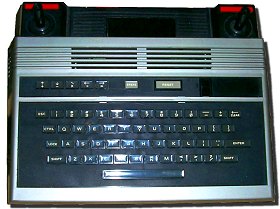 Not long after, NAP announced the Odyssey3 – with a more traditional keyboard, much more advanced graphics (including revamped versions of existing games like Pick Axe Pete), and the capacity for such peripherals as disk drives and modems – and it seemed like the Odyssey had finally advanced sufficiently to survive longer than the Atari 2600, which had also reached its hardware limits around this time.
Not long after, NAP announced the Odyssey3 – with a more traditional keyboard, much more advanced graphics (including revamped versions of existing games like Pick Axe Pete), and the capacity for such peripherals as disk drives and modems – and it seemed like the Odyssey had finally advanced sufficiently to survive longer than the Atari 2600, which had also reached its hardware limits around this time.
Then it disappeared. The third-party games were released in very limited numbers. The Odyssey3 project was not developed, and the Odyssey2 quickly vanished into obscurity. Home computers ruled the market now, and the home video game machines were pushed out of the way. Even higher-end home game machines like the Colecovision and Atari’s 5200 and 7800 models lost out to the fledgling PCs, the Apple II and the Commodore 64. The first home video game revolution ended after barely a five-year reign. The time of the home game system would not arrive again until the late 1980s with the names of such firms as Nintendo and Sega at the forefront. But in that time, computers had become prevalent, and the heart of video gaming had changed from an abstract form of entertainment with the emphasis on compulsive playability to a more violent, realistically gritty style with more attention to bells and whistles.
[jwcatpostlist orderby=title order=asc includecats=25,41,319]
Odyssey3 photo courtesy of Fred Hiss.
Las Vegas Blackjack!
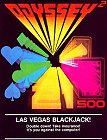 The Game: Place your bets, ditch some cards, or play with the ones you’ve got. The computer offers the usual enticements – double down and insurance – but the odds are firmly in favor of the house. There’s no limit on how big your bet is, so you’re even free to bet an ante that’ll have you screaming “uncle!” if you lose. (Magnavox, 1978)
The Game: Place your bets, ditch some cards, or play with the ones you’ve got. The computer offers the usual enticements – double down and insurance – but the odds are firmly in favor of the house. There’s no limit on how big your bet is, so you’re even free to bet an ante that’ll have you screaming “uncle!” if you lose. (Magnavox, 1978)
Memories: I’m not a big fan of card games. In fact, when I got hold of this rather common cartridge recently, the lovely Mrs. PDF actually had to teach me how to play blackjack. I was hopeless. But it’s grown on me. I’ve now had the opportunity to play both this Odyssey 2 version and a Game Boy Color edition which is part of a card game cartridge called Las Vegas Cool Hand. And I have to say I like the Odyssey version better.
Dodge It
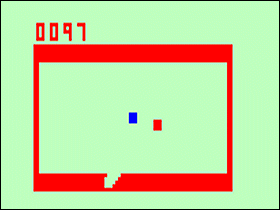 The Game: Trapped in a square or rectangular arena, the player is represented by a mobile square. Another projectile punches its way into the arena and begins ricocheting around; points accumulate rapidly the longer the player’s square avoids contact with the projectile, but starting at 200 points, an additional projectile is added every 100 points, each on its own chaotic, bouncing path. The game ends when the player inevitably collides with one of these projectiles. (Fairchild, 1978)
The Game: Trapped in a square or rectangular arena, the player is represented by a mobile square. Another projectile punches its way into the arena and begins ricocheting around; points accumulate rapidly the longer the player’s square avoids contact with the projectile, but starting at 200 points, an additional projectile is added every 100 points, each on its own chaotic, bouncing path. The game ends when the player inevitably collides with one of these projectiles. (Fairchild, 1978)
Memories: Nearly every system, no matter how obscure, has at least one unique game that’s worth seeking out both hardware and software, just to try it out and see how much fun it is. Some systems, like the Atari VCS and the Intellivision, have something like half a dozen “killer apps”. When I played Dodge It on the Fairchild Channel F, it was one of those occasions where I looked up at the clock, and realized two things: it was an hour later, and I was still playing Dodge It. It’s a unique concept that I hadn’t seen elsewhere, maddeningly simple and insanely addictive. Dodge It made it worth my while to have a Channel F hooked up in my game room.
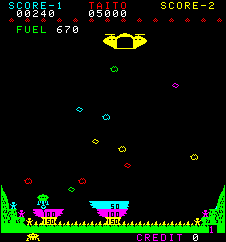
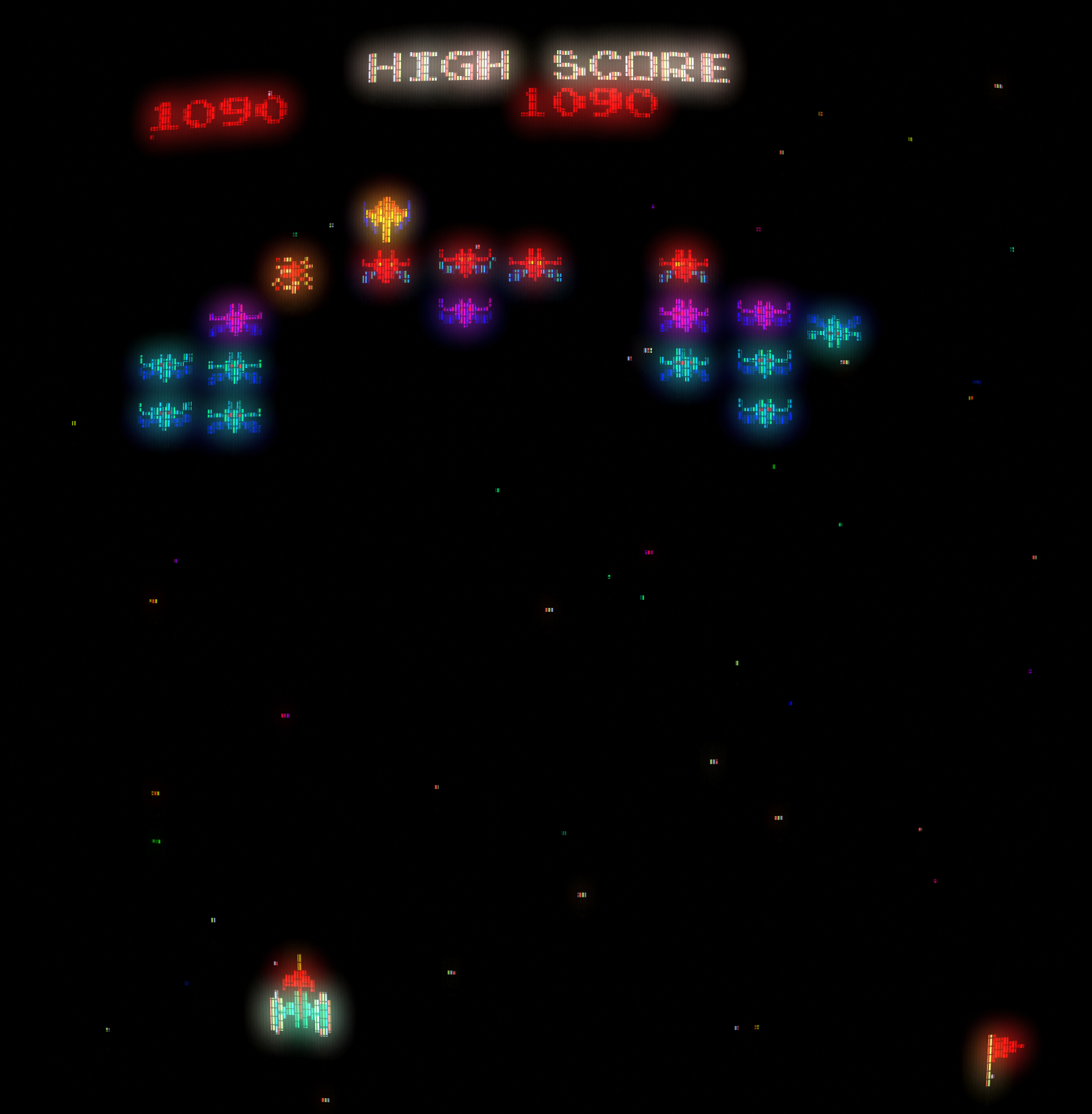
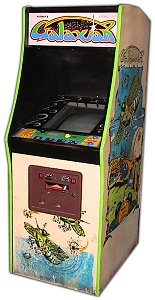 The Game: In one of the most seminal variations on the Space Invaders format, Galaxian was among the first clones to introduce attacking formations that would break off from the usual rows and columns of
The Game: In one of the most seminal variations on the Space Invaders format, Galaxian was among the first clones to introduce attacking formations that would break off from the usual rows and columns of 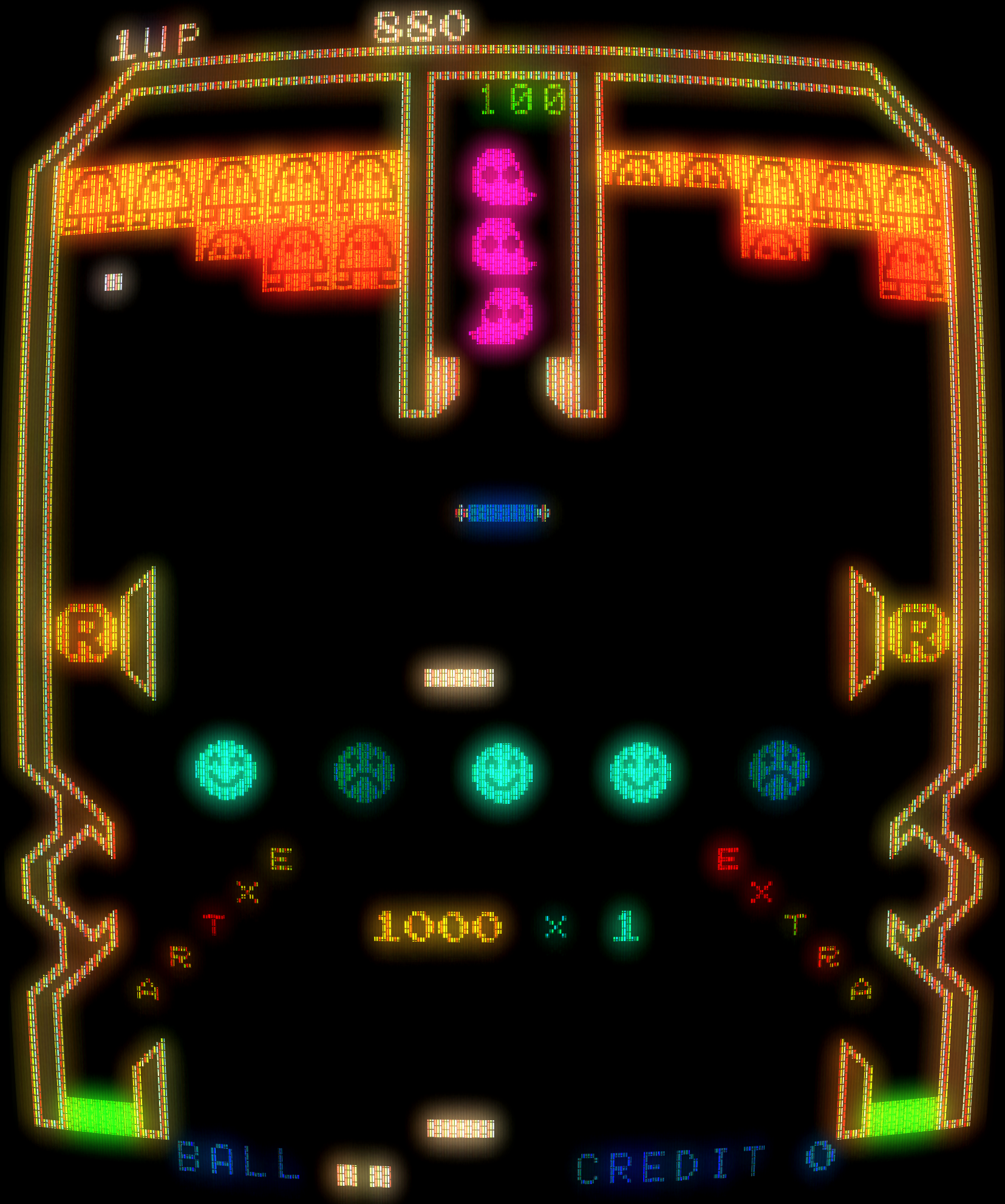
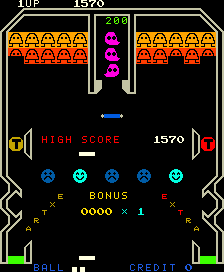
 The Game: Video pinball is back, and now in more than one color! Bomb Bee takes the game mechanics of Gee Bee and makes them noisier and brighter, adding “bumper traps” that can keep the ball bouncing in tight cul-de-sacs, racking up massive bonus points with every strike. (Namco, 1979)
The Game: Video pinball is back, and now in more than one color! Bomb Bee takes the game mechanics of Gee Bee and makes them noisier and brighter, adding “bumper traps” that can keep the ball bouncing in tight cul-de-sacs, racking up massive bonus points with every strike. (Namco, 1979)
 The Game: It’s a one-on-one hardwood hoedown as two players control tank-topped, gym-socked hoops stars in an effort to bank the most baskets. Whoever buckets the most balls by the end of the game’s preset timer wins. (Atari, 1979)
The Game: It’s a one-on-one hardwood hoedown as two players control tank-topped, gym-socked hoops stars in an effort to bank the most baskets. Whoever buckets the most balls by the end of the game’s preset timer wins. (Atari, 1979)
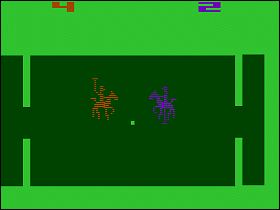 The Game: Climb onto your trusty four-legged ride for a good old fashioned game of horse hockey. Try to knock the ball into your opponent’s goal, but don’t put yourself in a position where you can’t defend your own. (Atari, 1978)
The Game: Climb onto your trusty four-legged ride for a good old fashioned game of horse hockey. Try to knock the ball into your opponent’s goal, but don’t put yourself in a position where you can’t defend your own. (Atari, 1978)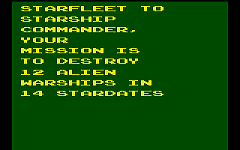
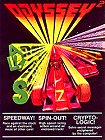 The Game: In Speedway!, one player guides a race car through an endless onslaught of slower-moving traffic, Monaco GP style; colliding with anyone stalls the game for a moment. Two players are required for Spin-Out!, a copycat of Atari’s Sprint 2 coin-op, in which two race cars zip around a convoluted little track in an attempt to be the first one to rack up three laps. Crypto-Logic! lets you type in up to 18 characters on one line, and hit the enter key to completely scramble those characters. A second player then has to figure out what the jumble of letters was with as few misses as possible. (Magnavox, 1978)
The Game: In Speedway!, one player guides a race car through an endless onslaught of slower-moving traffic, Monaco GP style; colliding with anyone stalls the game for a moment. Two players are required for Spin-Out!, a copycat of Atari’s Sprint 2 coin-op, in which two race cars zip around a convoluted little track in an attempt to be the first one to rack up three laps. Crypto-Logic! lets you type in up to 18 characters on one line, and hit the enter key to completely scramble those characters. A second player then has to figure out what the jumble of letters was with as few misses as possible. (Magnavox, 1978)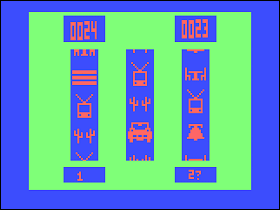
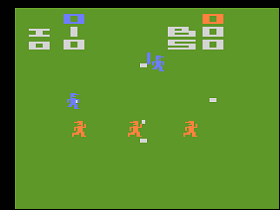
 The Game: Woooooo, Packers. Classic pigskin comes to sluggish life in this over-complicated video game edition. Despite the Odyssey’s full keyboard, the game forces players to look up plays in the manual and execute them with joystick commands. After that, aside from some minimal control of whoever has the ball, it’s a bit like watching an ant farm. (Magnavox, 1978)
The Game: Woooooo, Packers. Classic pigskin comes to sluggish life in this over-complicated video game edition. Despite the Odyssey’s full keyboard, the game forces players to look up plays in the manual and execute them with joystick commands. After that, aside from some minimal control of whoever has the ball, it’s a bit like watching an ant farm. (Magnavox, 1978) The Game: As man eked out his existence in the dark ages with only his animal cunning and the brutal power of the club, so do you in this golf simulation, in which you putter around nine different courses in an attempt to make a hole in one – or simply to stay under par. (Magnavox, 1978)
The Game: As man eked out his existence in the dark ages with only his animal cunning and the brutal power of the club, so do you in this golf simulation, in which you putter around nine different courses in an attempt to make a hole in one – or simply to stay under par. (Magnavox, 1978) The Game: You pays your money, you takes your chances. Pull the lever (or, in this case, the joystick) and try to get the fruit to line up. If you succeed, you’re in good shape; if you don’t, well, you’re out some more change. (Magnavox, 1978)
The Game: You pays your money, you takes your chances. Pull the lever (or, in this case, the joystick) and try to get the fruit to line up. If you succeed, you’re in good shape; if you don’t, well, you’re out some more change. (Magnavox, 1978)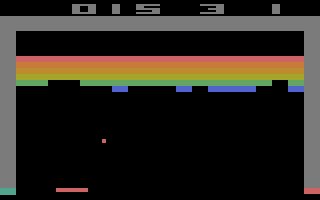

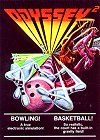 The Game: Hit the hardwood in one of two sports. Roll your big shiny one down the lanes and try to knock down all the pins in Bowling!, or go for a basket in Basketball! Not possible in Odyssey2 Basketball!: fouls, three-point shots, free throws, most steals… (Magnavox, 1978)
The Game: Hit the hardwood in one of two sports. Roll your big shiny one down the lanes and try to knock down all the pins in Bowling!, or go for a basket in Basketball! Not possible in Odyssey2 Basketball!: fouls, three-point shots, free throws, most steals… (Magnavox, 1978) The Game: In Baseball!, you are, quite simply, one of two teams playing the great American game. If you’re up at bat, your joystick and button control the man at the plate and any players on base. If you’re pitching, your button and joystick control how wild or straight your pitches are, and you also control the outfielders – you can catch a ball on the fly, or pick it up and try to catch the other player away from his bases. (Magnavox, 1978)
The Game: In Baseball!, you are, quite simply, one of two teams playing the great American game. If you’re up at bat, your joystick and button control the man at the plate and any players on base. If you’re pitching, your button and joystick control how wild or straight your pitches are, and you also control the outfielders – you can catch a ball on the fly, or pick it up and try to catch the other player away from his bases. (Magnavox, 1978)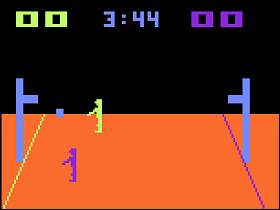 The Game: Two players each control one man in one-on-one, full-court action. Whoever has the highest score by a predetermined time limit wins. (Atari, 1978)
The Game: Two players each control one man in one-on-one, full-court action. Whoever has the highest score by a predetermined time limit wins. (Atari, 1978)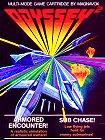 The Game: War is pixellated, blocky hell on the Odyssey2! In Armored Encounter, two combatants in tanks circumnavigate a maze peppered with land mines, searching for the optimum spot from which to blow each other to kingdom come. In Sub Chase, a bomber plane and a submarine, both maneuverable in their own way, try to take each other out without blasting any non-combatant boats routinely running between them (darn that civilian shipping!). In both games, the timer is counting down for both sides to blow each other straight to hell. (Magnavox, 1978)
The Game: War is pixellated, blocky hell on the Odyssey2! In Armored Encounter, two combatants in tanks circumnavigate a maze peppered with land mines, searching for the optimum spot from which to blow each other to kingdom come. In Sub Chase, a bomber plane and a submarine, both maneuverable in their own way, try to take each other out without blasting any non-combatant boats routinely running between them (darn that civilian shipping!). In both games, the timer is counting down for both sides to blow each other straight to hell. (Magnavox, 1978)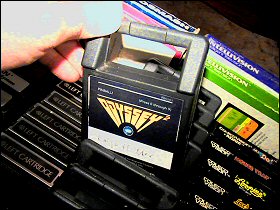 The Game: A virtual pinball machine is presented, complete with flippers, bumpers, and the ability to physically “bump” the table to influence the motion of the ball. Per standard pinball rules, the object of the game is to keep the ball in play as long as possible. (Ralph Baer, 1978 – unreleased prototype)
The Game: A virtual pinball machine is presented, complete with flippers, bumpers, and the ability to physically “bump” the table to influence the motion of the ball. Per standard pinball rules, the object of the game is to keep the ball in play as long as possible. (Ralph Baer, 1978 – unreleased prototype)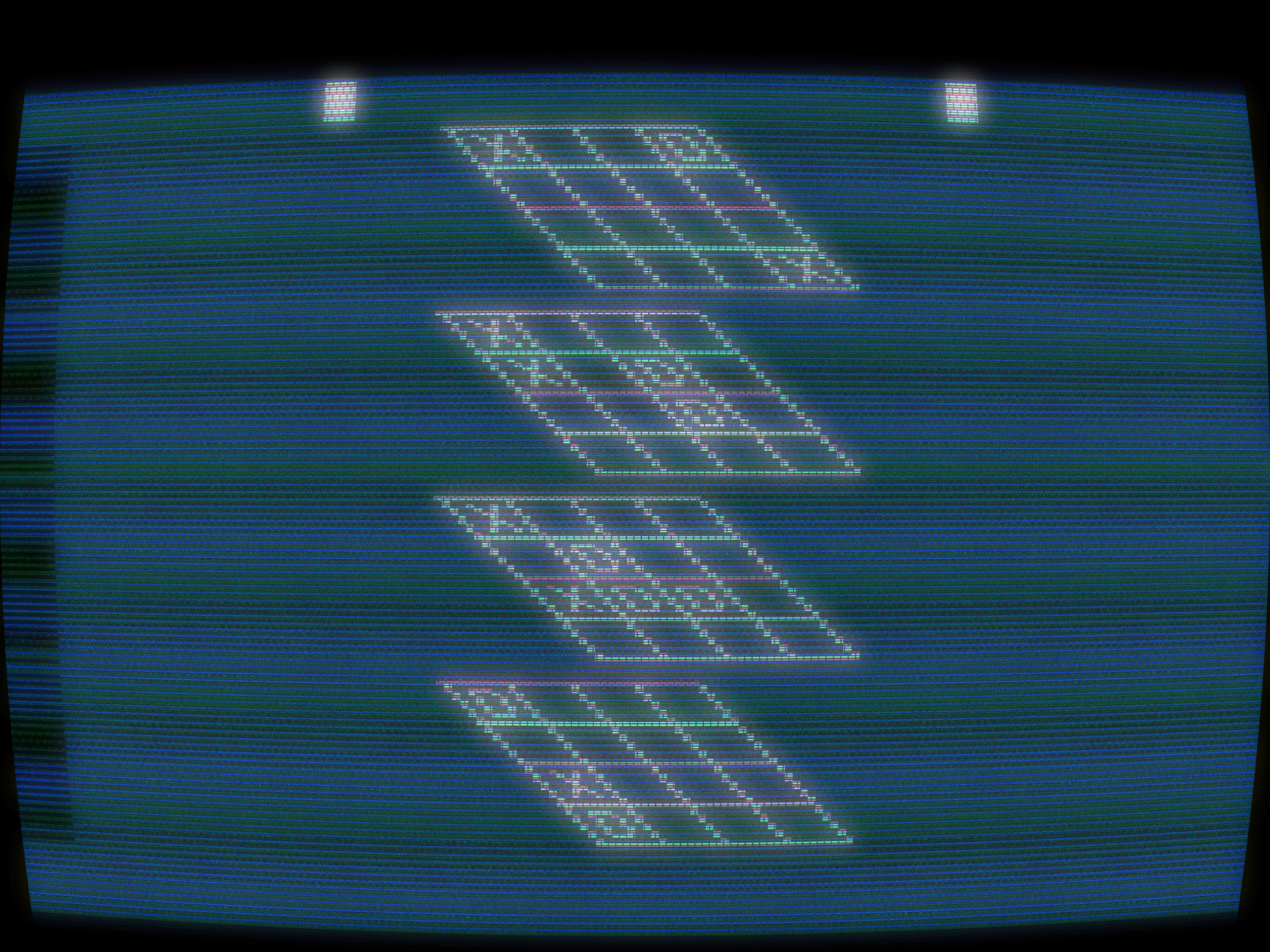
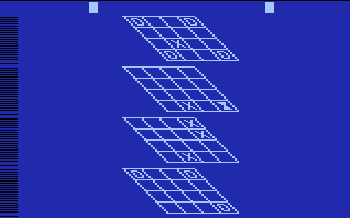
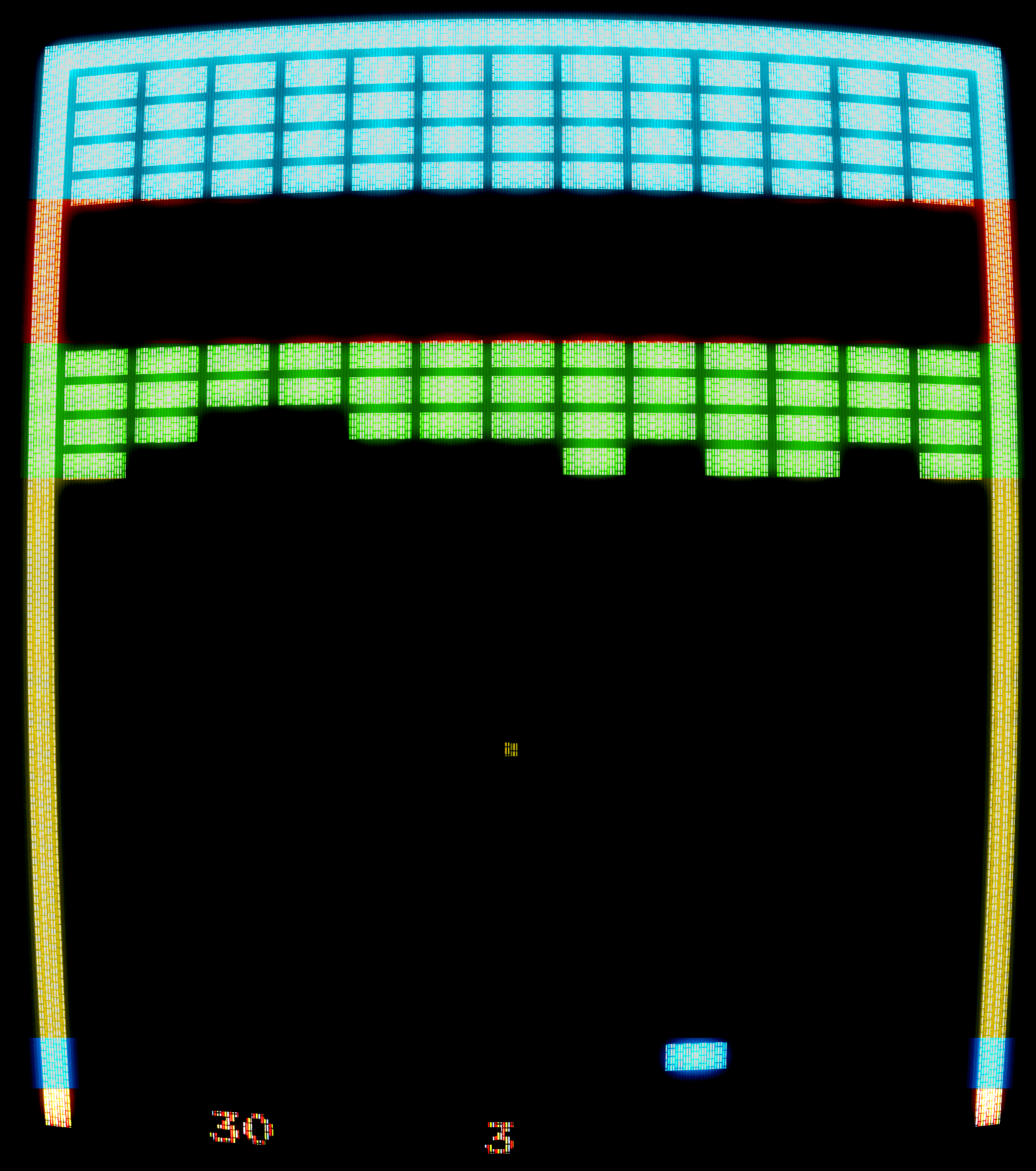
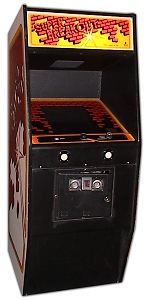
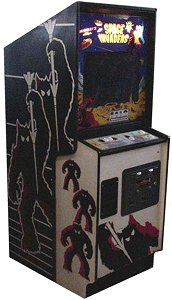
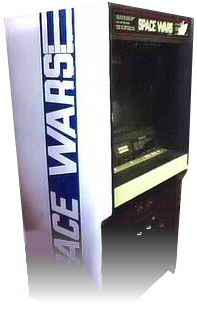 The Game: Two ships are locked in deadly deep-space combat, firing interplanetary ordnance at each other. Some variations include a sun whose gravity well will draw the immobile or the unwary to their destruction, or a roaming asteroid which can be a handy shield one moment and a killer obstacle the next. Whoever survives the most confrontations within a set amount of time is the victor. (Cinematronics, 1978)
The Game: Two ships are locked in deadly deep-space combat, firing interplanetary ordnance at each other. Some variations include a sun whose gravity well will draw the immobile or the unwary to their destruction, or a roaming asteroid which can be a handy shield one moment and a killer obstacle the next. Whoever survives the most confrontations within a set amount of time is the victor. (Cinematronics, 1978)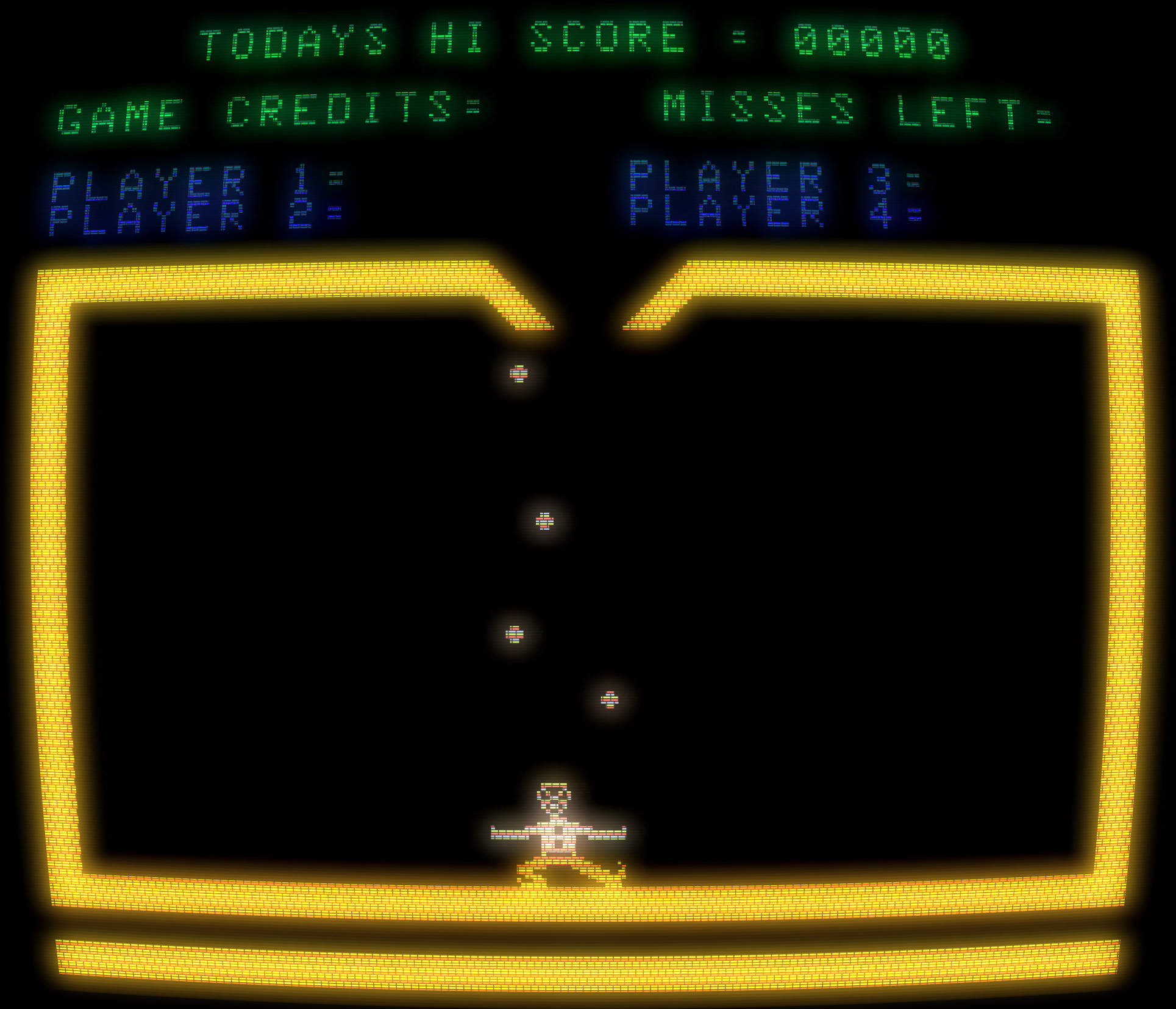
 The Game: One or more players take turns controlling the gypsy juggler, who is trying to keep his eggs in the air. Pressing the button releases another egg into the game, which the juggler much managed to keep in the air along with the previous eggs. If even a single egg splatters on the ground, a chick hatches and walks away disapprovingly, leaving the player with one less turn; the game ends when the player is out of turns. (Meadows Games, 1978)
The Game: One or more players take turns controlling the gypsy juggler, who is trying to keep his eggs in the air. Pressing the button releases another egg into the game, which the juggler much managed to keep in the air along with the previous eggs. If even a single egg splatters on the ground, a chick hatches and walks away disapprovingly, leaving the player with one less turn; the game ends when the player is out of turns. (Meadows Games, 1978) The Game: It’s like pinball, but not quite. Not only are the bouncing-ball physics and bumpers of pinball present, but so are walls of bricks which, when destroyed, add to your score and sometimes redirect your ball in unpredictable directions. Pinball meets Breakout. (Namco, 1978)
The Game: It’s like pinball, but not quite. Not only are the bouncing-ball physics and bumpers of pinball present, but so are walls of bricks which, when destroyed, add to your score and sometimes redirect your ball in unpredictable directions. Pinball meets Breakout. (Namco, 1978)